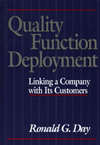Quality Function Deployment: Linking a Company with Its Customers Ronald G. Day Contents Preface Preface The author's experience over many years in industry has served as a constant reminder that most companies have not made an aggressive effort to understand their customers' wants and needs. Many companies depend on their warranty programs, customer complaints, and inputs from their sales staffs to keep them in touch with their customers. The result is a focus on what is wrong with the existing product with little or no focus on what the customer wants and expects in new product offerings. Furthermore, without the benefit of customer surveys, companies have little idea about how customers rate their company and how they rate the performance of their competitors. In these companies, new products are planned and brought to market without a real firsthand knowledge of the potential customers' wants and needs. Simple logic says that products designed without knowledge of the potential customers' requirements will frequently fail to satisfy their needs. Sales will not meet their potential. Competitors who listen to the customer and bring out products that respond to their needs will compete more effectively and gain market share. The methodology of quality function deployment (QFD) employs the customers' wants and needs as its basic input. It was this aspect of QFD that first attracted the author's attention to the process. If companies could be encouraged to use QFD as a methodology during product development, it would force them to listen to their customers. Thus, for the first time, many companies would be put in touch with existing and prospective customers and the knowledge gained would help them develop more competitive, state-of-the-art products for their markets. This is the aspect of QFD that continues to hold the author's attention—it is a process that puts companies in touch with their customers and helps them develop products that are more customer oriented and responsive. It is a process to increase competitiveness and develop a base of satisfied customers. For many industries threatened by global competition, this level of customer focus and response is necessary for survival. This is a pragmatic book. It is intended as a guide for practitioners. It captures much of the pertinent experience gained during the last 8 years since the author first investigated and started working with the concept. It is intended to give users an insight into the use of the QFD matrix in a variety of applications. It presents the author's experience and ideas on how to handle some of the typical problems experienced in using the QFD matrix concept. QFD was introduced to the United States in the early 1980s. Several articles and translations of Japanese examples appeared shortly after its introduction which were based largely on observations of Japanese applications. The American Supplier Institute (ASI) in Dearborn, Michigan, and GOAL/QPC in Methuen, Massachusetts, have been the primary organizations offering an overview and workshop-type training since that time. Beginning in 1989, ASI and GOAL/QPC have jointly sponsored annual seminars to update the level of QFD knowledge. The recent emphasis on company-wide processes to improve internal operations and competitiveness has caused many companies to examine the ideas of total quality management, the ISO 9000 standards, and the Malcolm Baldrige National Quality Award requirements. Many companies have been introduced to the importance of knowing their customer through their investigation of these company-wide program concepts. Typically, as the QFD experience has increased and the knowledge base has expanded, many new ideas and approaches have emerged for handling the data and numerical portions of the matrix. Software has been developed to facilitate the construction of QFD matrices. This process of exploration and refinement will continue, as it does in all disciplines. The real challenge, however, is a much more pragmatic one. American companies still need to come to grips with the fact that they must be in touch with their customers, that they must fund programs for customer research, and that the process must be a continual one. They must use some organized method to examine these customers' wants and needs and translate them into action within their companies. This is the challenge. It is the intent and purpose of this book to explore issues germane to this focus. The examples used in the book are generic. They are based on the experience of many companies. Companies that have invested funds to determine the "voice" of their customers typically find a number of issues that are important to their customers and that they will incorporate into their next product developments. From a competitive viewpoint, the opportunity offered through this customer knowledge would be lost if it were published. In recognition of the confidential and proprietary nature of every QFD study, the information and data used in this book have been altered substantially. Some examples were developed strictly to help enhance an understanding of certain aspects of the process. One of the principal ideas behind this book is to provide insight into the use of QFD in nonproduct applications. The author believes there is a major opportunity for application in these areas and hopes that this text will encourage people to investigate this potential. |
||||
